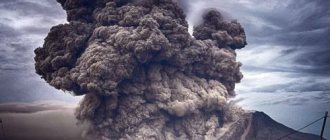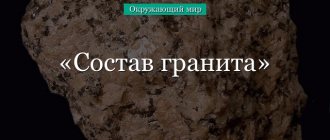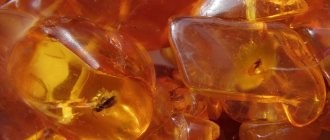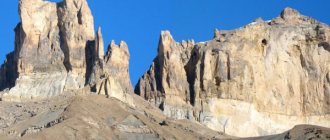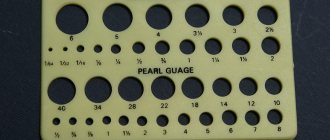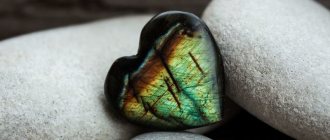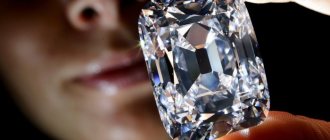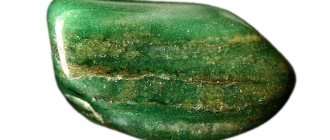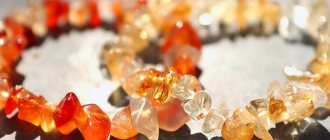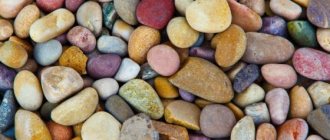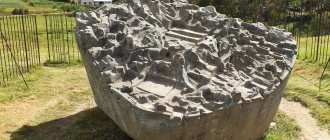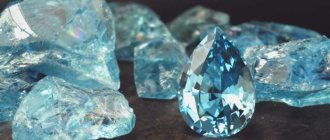4.6
Average rating: 4.6
Total ratings received: 757.
4.6
Average rating: 4.6
Total ratings received: 757.
There are a lot of different stones on our planet, which differ from each other in shape, size, color, and properties. These are majestic mountains and fine-grained sand, natural minerals and precious gems. At first glance, the stones seem very strong and durable, but even they are susceptible to destruction.
What are stones?
All stones are solid mineral material that covers almost the entire surface of the Earth, including its underwater part.
At the very beginning of its formation, our planet consisted of fire, water and rocks. Streams of lava erupted from fire-breathing volcanoes, mighty mountains collided, mercilessly destroying each other. As a result, large and small pieces broke off from young rocks and rolled down, sweeping away everything in their path. So the stones filled the entire globe.
Rice. 1. Stones.
Stones are solid bodies, objects of inanimate nature. They can be small or large, with a smooth or rough surface, regular or abstract in shape.
All natural stones are divided into 3 broad groups:
- Precious . Very beautiful stones from which jewelry is made. These are emerald, diamond, sapphire, ruby, aquamarine.
Rice. 2. Diamond is the most durable stone in the world.
- Semi-precious . Also used in the manufacture of jewelry, boxes, dishes, and decorative items. These are agate, rock crystal, quartz, opal.
- Ornamental . Used in construction and in the manufacture of household items. These are granite, marble, obsidian, selinite, onyx.
Popular message topics
- New York
Undoubtedly, literally everyone has heard about this city. It can be called the center of the world. It is here that many attractions and various institutions from educational to cultural are concentrated. There are plenty of activities and places to - Peoples of Western Siberia
Siberia is a region with a harsh climate and a minimal percentage of population. This place excites the imagination. Despite the vast territory, there are relatively few settlements. Accordingly, the peoples are few in number. - Ancient Athens
Athens is an ancient Greek polis (city-state), which flourished in the 5th century BC. It has been the hallmark of Greece for more than two millennia.
How rocks are destroyed
Stones are prone to destruction under the influence of external factors. These include:
- Temperature . On warm, sunny days, the stones heat up and cool down at night. As you know, when heated, solids expand, and when cooled, they contract. It is noteworthy that in different areas heating occurs with different intensities. As a result, expansion and contraction also occur unevenly. Gradually, cracks form in the stones and rocks, into which water enters. When it freezes, it begins to put pressure on the walls of the cracks with enormous force, literally bursting the rocks from the inside. Sooner or later they cannot stand it and break into smaller pieces.
Rice. 3. Cracks in the rocks.
- Wind . Strong gusts of wind blow smaller particles off the surface of the stones. During a strong storm, the wind carries a huge amount of small sand particles. Colliding with stones at high speed, they act like sandpaper, polishing and changing the shape of their surface.
With the wind, plant seeds can fall into the cracks of rocks and germinate directly in the rock. The growing roots gradually widen the cracks and break the stones.
At the foot of the cliffs you can always find scatterings of small stones. The impact of wind is the weakest factor, since the destruction of stone occurs over many hundreds and thousands of years.
TOP 3 articles
who are reading along with this
Where do the rivers flow (the world around us, 1st grade)
The world around us (4th grade): Rus' spreads its wings
Travel around Moscow
- Water . After snow melts and heavy rains, powerful streams of water pick up stones and roll them over, carrying them over long distances. During their “travels,” the stones are ground against each other, crushed, gradually turning into clay and sand.
UMK "Perspective". 1 class. Lesson about the world around us. Topic: BEAUTIFUL STONES IN OUR HOUSE.
Lesson : BEAUTIFUL STONES IN OUR HOUSE
Lesson objectives
: to introduce stones as part of inanimate nature, to show the beauty of stones and products made from them, to teach to recognize a stone in a product.
Planned achievements of students
: learn to distinguish between commonly encountered ornamental stones and recognize them in products.
Lesson progress 1 Organizational moment
There are many interesting things in the world, sometimes unknown to us.
The world of knowledge has no limit. So hurry up, friends, get to work! Be attentive, active and diligent. 2. Updating knowledge:
1.- Each of you came to school for some purpose. Which? (learn something) - “One wandering seeker of truth saw a large stone on which was written: “Turn over and read.” He turned it over with difficulty and read on the other side: “Why are you looking for new knowledge if you don’t pay attention to what you already know?” How do you understand the meaning of these words? (we need to learn new things without forgetting the old) (slide) - What is the name of the section we are studying? (Our home and family) (slide) - What have we learned about the family? (a family is part of the people, each family has its own traditions) -What have we learned about the house? (nature in the house, where water, electricity, gas comes into the house from...)
3.Self-determination for educational activities.
(slide) - Guys, today I brought a box to the lesson about the world around us.
Are you wondering what's in it? Then listen to my story: (slide) “This subject from time immemorial has become firmly established in human life. Many thousands of years ago it was used as a tool. They could grind cereal grains into flour, smooth skins, and start fire. And with shiny and colorful ones, people have long loved to decorate themselves and their homes.” -Who guessed what was in my box? Let's check. - What are we going to talk about in class? —Where can you see stones? Remember the title of the section, cat. we are studying and formulate the topic of our lesson “Beautiful stones in our house” (slide) -What would you like to know about stones? · What are stones?
(slide) ·
When and how did they appear?
·
How are they different from each other?
·
Information about some stones.
·
How does a person use stones in his life? 4. Identifying the location and cause of the difficulty.
- Pay attention to the screen, there is a whole collection of stones. (slide) - Look at them and give them a name. - Can we name all the stones now? Why? (Not enough knowledge) - Where can we find information about these stones? (ask adults, read in a book....) - We will use the textbook. Page 60.
5. Discovery of new knowledge.
a) What are stones and how are they formed.
- Read the 1st paragraph. (Stones are part of inanimate nature. Look how beautiful they are!) - What question did you find the answer to? (What are stones?) - Remember what stones served for primitive people? (dwelling, tools, weapons for hunting) We learn about how stones appeared by unraveling the message of distant ancestors carved on stones. (picture: sea b/w on stone) (slide) Some stones appeared as a result of the fact that In the seas and oceans, the remains of various organisms settled to the bottom, eventually turning into stone. This stone is called limestone. -At school we also use limestone, who guessed what it is? (CHALK) In Moscow, the Assumption and Archangel Cathedrals, built of limestone 500 years ago, still stand. (slide)
— How else are stones formed? (picture: volcano b/w on a stone) Most stones are born in the depths of the Earth and, together with the hot internal substance of the Earth, magma is carried to the surface during a volcanic eruption. - Let's see how this happens. (Experiment. We prepared a model of a mountain in advance from plaster, inside a container. We put “painted foam stones” on the bottom, add red food coloring, water, vinegar, a spoonful of dishwashing liquid. In order to see how a volcano erupts, just add a spoonful of soda The spectacle is impressive!!!)
b) General information about stones and their use.
1. We say “stones,” but in science we distinguish between minerals and rocks.
Minerals are natural substances that have a homogeneous composition, and rocks are compounds of several minerals. For example: granite
, colored grains are clearly visible in it.
Find granite in your textbook and place a white pebble chip on it. Granite is a very strong and durable rock, so embankments and houses, bridges, monuments and metro stations are lined with it, and sculptures are created from it. In St. Petersburg, the pedestal of the monument to Peter the Great is a giant granite stone found on the shores of the Baltic Sea. (slide) 2. The next stone was named after the Greek goddess of the Moon - Selene. -Can you guess what this stone is called? ( selenite
). Find it in the textbook and move the piece. Selenite is a “relative” of the same plaster that is applied to a broken arm or leg. However, selenite is beautiful with its iridescence, as if it is permeated with moonlight. Therefore, it is sometimes called moonstone. Selenite is a soft stone, it is used only for small crafts that decorate people’s homes. (slide)
3. This stone has been known since ancient times. Its color ranges from bright blue to dark purple. What is this stone? ( lapis lazuli
) Move your pebbles. In our country, lapis lazuli is mined in the mountains near Lake Baikal. Not only crafts were made from lapis lazuli, but also large vases, which are now kept in the Hermitage. In the Hermitage there is a hall with columns lined with lapis lazuli (slide).
4. In Persian the name of this stone is “firuza”, which means “stone of happiness”. Say his Russian name. ( turquoise
). Place the chip on the “stone of happiness.” Turquoise is a stone that is blue or even green in color. Its color is very unstable. In the sun it turns pale, and under the influence of soap, perfume, and alcohol it turns green. Therefore, turquoise jewelry and talismans must be handled very carefully.
5. According to legend, one day the sky could not withstand the enormous weight of the big sun and accidentally dropped it into the sea. Cold waves cooled it as it fell, and sharp rocks on the seabed broke it into small pieces. -What stone are we talking about? (Amber
).
Let's move the chip. A distinctive feature of amber is its golden color. (showing through a document camera) Amber is the frozen resin of ancient coniferous trees. Especially a lot of amber is found on the coast of the Baltic Sea, where it is thrown ashore by waves. Various jewelry and paintings are made from amber. And in the Hermitage there is an Amber Room. (slide) 6. This stone has long been mined in the Urals along with copper ore, which is why it has the color of a silky delicate green. -What stone are we talking about? Let's move the chip.
, small things were made
from malachite In the Hermitage there is a malachite living room, in which everything is lined with Ural malachite. (slide) Malachite is also known from Pavel Bazhov’s tales “The Malachite Box”, “Mistress of the Copper Mountain.” (slide) Maybe some of you have watched cartoons based on these works . Do you want to learn how to make malachite with your own hands? Then watch and remember. (Experiment: Place water in a shallow bowl, pour green and black oil paint on top, mix. Dip a sheet of cardboard into the water for a few seconds and take it out.)
From the dried sheet, you can make a real malachite box.
6. Physical education minute.
7. Primary consolidation. a) Practical work paired with testing against a standard.
On page 61, find stone products.
The name of the stone will appear on the board, you will need to place 1 chip on the stone p.60, and the other on the product that is made of this stone. (malachite, granite, selenite, amber, lapis lazuli, turquoise) - check one stone at a time on a slide. - Raise your hands whose couple did not make a single mistake!... 1 mistake... b) Work in a notebook.
Open your notebook on page 46, find task No. 2.
Read it. Where do we find the answer to this question? Let's open the atlas-identifier tab p. 17. - Find and write down the names of the stones in the boxes. -Which of these stones have we not talked about yet? (corals) -What do you know about corals, who has seen them in nature? I suggest you watch the film
. (30 sec) (Voice over: Corals are amazing stones. They were created by polyps - small sea animals no larger than an ant, there are hundreds of thousands of them. Year after year they build themselves limestone houses, and as a result they get such underwater castles For polyps to build, the place must not be deep, light and warm, and the water must be clean and salty.)
c) Display of products made from precious stones.
Now the time has come to open the magic box. -What do you think is in this box? (jewelry made from stones) · This ring is made of a red ruby, it can also be pink. · These are earrings made of amethyst and cubic zirconia. · Alexandrite is a stone that can change color depending on temperature and lighting. · beads made of pearls, · Monomakh's Cap - the main regalia of the Russian Grand Dukes and Tsars. — Why did the headdress appear on the screen, who will explain? (It is decorated with precious stones: pearls, rubies, emeralds and a golden cross.)
There are about 3,000 different stones in nature. “Each stone is given its own,” said Bazhov. -Do you want to know which stone is your talisman? To do this, find the month in which you were born and read the name of the stone below. (the work itself) -Name your talisman.
8. Independent work with mutual checking according to the standard.
And now we will collect our collection of stones. Workbook p.45 Take the envelope. Take out images of stones from it and place them on your shelves. To work you will need glue. (During work, the Aria of the Indian Guest from the opera “Sadko” sounds: You can’t count diamonds in stone caves, You can’t count pearls in the midday sea)
· mutual verification using the standard from the board. Rate your friend's work: no errors - red circle, 1-2 errors - green, more than 2 - blue. Stand up those who received a red and green circle....
Creating conditions for motivation to perform D/Z
Now I offer you for viewing a fragment from the cartoon “Silver Hoof”, based on Bazhov’s work.
cartoon “Silver Hoof”
D/Z find out what these stones were called and in the workbook on page 47 draw for your beloved mother any decoration made from these stones.
9. Reflection of activity.
Lesson summary. To summarize the lesson, let's return to the tasks at hand.
Let's check what questions we could find the answer to today? (return to slide) Finish any of the sentences: - I found out... - I realized that... - I did it... On the slide are drawings of three little men. -
Do as the little man does, if: - hands up - this little man has learned new knowledge, - hands to the sides - this little man has learned new knowledge, but sometimes he still needs help, - hands down - this little man is upset, the topic is perfect for him today incomprehensible.
Human impact
The strong human impact on the environment should also be taken into account. For their own needs, people rebuild the landscape: change the direction of rivers, blow up mountain ranges, build tunnels and communication routes. The earth's surface is exposed to the greatest impact due to technogenic processes.
Since ancient times, people have been mining minerals such as precious stones, ore, and construction materials. Quarries, mines and mines are developed for production. As a result of the continuous pumping of minerals over the centuries, many sources have been exhausted.
In the 20th century, industry replaced human labor. Various mechanisms and explosives began to be used to extract natural deposits. Drilling rigs increased the scale of production and accelerated the destruction of rock surfaces. Changing the landscape invariably leads to the death of the ecosystem. Due to changes in habitats, many animal species are on the verge of extinction.
The development of wells for mining and deforestation leads to avalanches and the collapse of mountain structures. In addition to the destruction of natural mountains, man creates new ones - artificial piles of processed rocks extracted during the extraction of ore from mines and quarries. Such anthropogenic mountains are called waste heaps; they are often reclaimed - trees are planted, and cultural objects are created from them.
